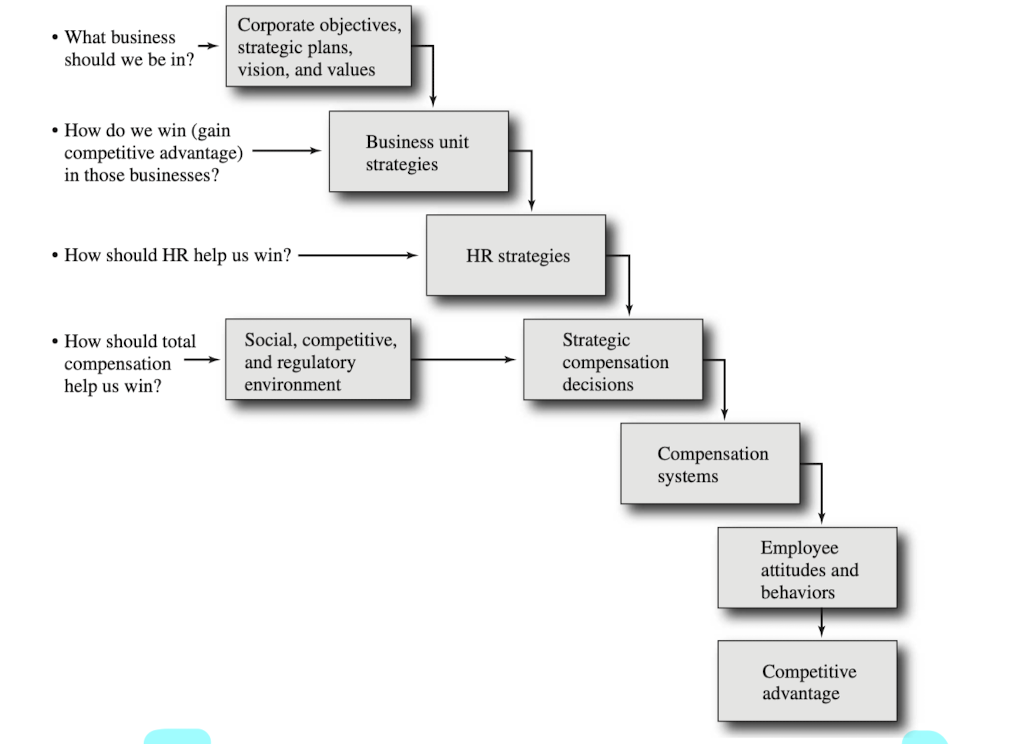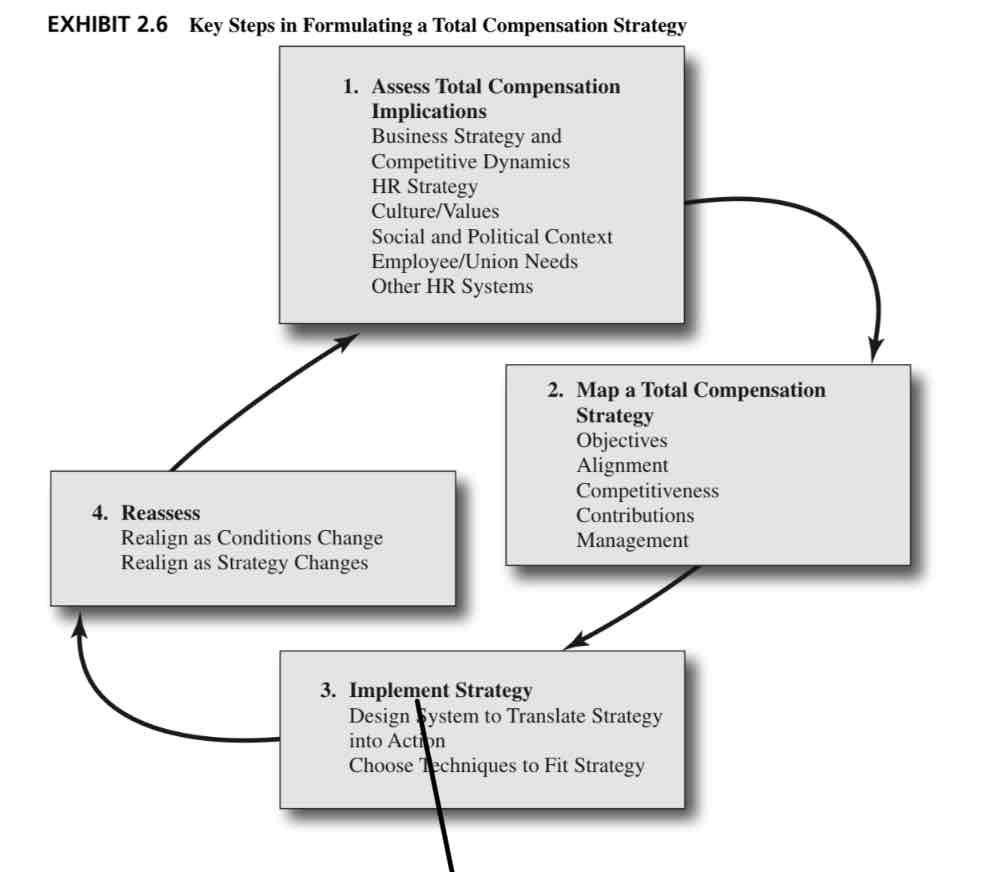MGMT 434 Compensation
1/26
Earn XP
Description and Tags
Name | Mastery | Learn | Test | Matching | Spaced |
|---|
No study sessions yet.
27 Terms
Total Compensation
All forms of financial returns and tangible services and benefits employees receive as part of an employment relationship
Cash Compensation
Base Pay
Cost of Living
Short term incentives
Long term incentives
Components of a Pay Model
Objectives: Fairness, Efficiency, Compliance
Techniques: Internal Structure, Pay structure, Pay for performance, evaluation
Policies: Internal Alignment, External Competitiveness, Contributions (pay for performance)
How does Internal Alignment fit into the pay model?
it supports the way the work gets done, fits the business strategy and ensures fairness to all employees
Compensation Objectives
Efficiency
Fairness
Compliance
Ethics
Three Policy Choices
Internal alignment
External Competitiveness
Contributions/Pay-for-Performance
Internal Alignment vs. External Competitiveness
Internal Alignment refers to pay comparisons among jobs or skill levels inside and organization
External Competitiveness refers to pay comparisons with competitors int he same industry
What is the link between performance and compensation?
How people are paid affects their behaviors at work, which in turn affects an organizations success, strategic compensation increases motivation and performance
Are relational returns part of total compensation? TRUE OR FALSE
False
Strategy Types
Cost Leadership-Lowest cost producer and to compete on the basis of cost
ex:Walmart
Cost Leadership Focus-Strategy to compete based on a narrow scope of industry
ex:Ross (retail /clothing) Dollar General (not a full array of products but priced to move)
Differentiation-Strategy to be unique in an industry on dimensions that are valued by customers
ex:Nordstrom
Differentiation Focus-Niche market but there still must be customer needs to address
ex:Anthropologie (strategy to sell unique and pricey clothes, furniture, and accessories)
What does it mean to take a “strategic perspective” to compensation?
Focus on those compensation choices that help the organization GAIN and SUSTAIN competitive advantage
Cascade of Strategic Choices
At Corporate level- “What business should we be in”?
At the business unit level- “How do we gain and sustain competitive advantage in this business”?
At the function level- “How should total compensation help this business gain and sustain competitive advantage”
The ultimate purpose- the “so what?”

What are the tests of competitive advantage?
Align: with business strategy, externally with the economic and sociopolitical conditions, internally with the overall HR system
Differentiate: how different is it from everyone else’s
Add Value:
Internal alignment
pay relationship among different jobs/skills/competencies within a single organization
“internal equity” jobs that are moe valuable are paid more
Pay level and differentials
An internal pay structure can be defined by 1)the number of levels of work, 2)the pay differentials between the levels, 3) the criteria or bases used to determine those levels
Content
refers to the work performed in a job and how it gets done (tasks, behaviors, knowledge required, etc)
Value
refers to the worth of the work: its relative contribution to the organization objectives
What are some organizational factors that shape internal alignment?
Strategy-pay structures that are not aligned with the organization strategy may become obstacle’s to the organization’s success
Technology-
Human Capital -the greater the value added by the skills and experience, the more those skills will command
HR Policy-if an organization has more levels, it can offer more promotions, but there may be smaller pay differences between levels
Employee acceptance-employees judge the fairness of their pay through comparisons with the compensation paid to others for work related in some fashion to their own
Cost implications
Hierarchical pay structure
send the message that the organization values differenced in work content, individual skills, and contributions to organization
Egalitarian pay structure
have fewer level and smaller differentials between adjacent level and between the highest-and-lowest paid workers
sends the message that all employees are valued equally
CONS: can become a barrier for recruiting, can mean that the more knowledgeable employees feel underpaid
In terms of internal alignment, which is NOT a consequence of a well-designed pay structure?
Workers are motivated by productivity incentives
Which is not true about tournament theory?
Evidence shows it applies well to pay structures in general
What is the primary reason Lockheed has a large differences in pay?
Adds more value to the company (A)
Compensation strategy aligns with
all of the above
4 types of cash compensation include everything but..
Income protection
Which of the following within a pay system is accurate?
Compensation objectives shape pay policies
Formulating a total compensation strategy
Assess Total Compensation Implications
-Business strategy and Competitive dynamics
-HR strategy
-Culture/values
-Social and political context
-Employee/union needs
-other HR systems
Map a total compensation strategy
-Objectives
-Alignment
-Competitiveness
-Contributions
-Management
Implement Strategy
-design system to translate strategy into action
-choose techniques to fit strategy
Reassess
-reassess as conditions change
-realign as strategy changes
